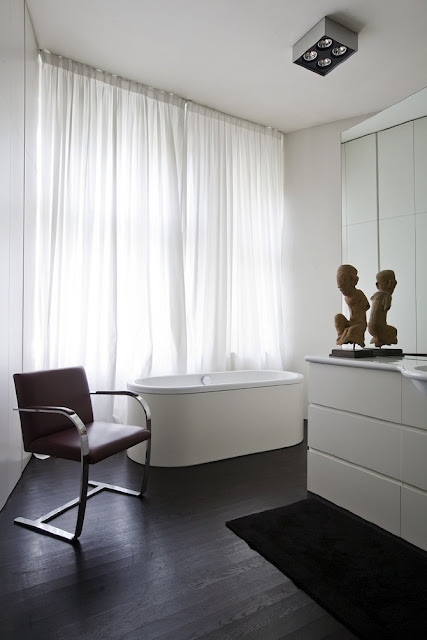




Bright flashes of color against an luxurious monochromatic backdrop denote the Berlin home of landscape architect Guido Hager. From an article by photographer Helenio Barbetta:
"There isn't even one indoor plant in Guido Hager's Berlin apartment. We'd foolishly assumed that in private this landscape architect would have a personal hothouse to look after, in which to cultivate Begonia coccinea, Farn trees, or some other rare domestic species. But he says that although he likes trees "I only like them when ther're outside. I don't feel any need to have them inddors." He comes here to stay for a few days each month, to go to the opera or see an exhibition, or just relax and spend time with friends. And also to see his personal collection of paintings and drawings, which continue to inhabit the apartment when he isn't there.
When he's not in Berlin he's probably living in his main house in Zurich (where he does have a conservatory, but that's another story) and where hi and his two partners firm of Hager Partner AG is located, with a staff of forty people who are currently working on more then 70 projects that range from private gardens to urban parks and public commisions, such as the esplanade fot the Etnographic Museum in Geneva and the tree-filled inner courtyard of the new Bundestag building. Hager's work is involved with Nature, but art collecting is a passion he cultivates in his spare time. He began collecting by chance: "Twelve years ago I happened to go into a gallery in Zurich, saw a painting I liked, and bought it. "Now he owns something like three hundred paintings and drawings, a few photographs, but no videos. "A gallery-owner friend of mine has tried to suggest what I should and shouldn't buy, but I won't listen to him. When I'm investing in art I buy, what I like.
Hager has a predilection for artists who are his own contemporaries, people born in the Fifties and Sixties, and for large canvasses. When he was looking for somewhere to live in Berlin, those "details" of his personal taste were a significant influence on his buying decision. "As my art collecting grew bigger" he says "my first apartment was becoming too small, so I started to look for somewhere else. It had to be in Schoneberg because I wanted to stay in the same area, which has a wonderful vegetable and flower market, but not in one of those lofts of which there are so many here. It was much better to go for a solid bourgeois home, organised in a traditional way with clearly separated living and sleeping areas, and stucco decorations adorning the ceilings".
And that was his perfect solution: an apartment at the fourth floor of an historic building, with three large rooms in a main wing and a "rear part" suitable for converting into two bedrooms and a bathroom. The general condition of the place was very poor and all the wiring needed to be replaced, but he was completely captivated by the walls, which offered plenty of hanging space that would be the perfect setting for the bright colours of his paintings.
Now the walls have been repainted white over a special new plaster finish that brings out the colour tones of the canvasses. The ceilings are also white, as a contrast with the black wood he chose for the floors. In the living area, which faces north, the natural daylight is very beautiful, and is assisted by a system of adjustable spotlights in the fairly challenging task of enhancing the works of art. The apartment also contains a few other light fittings: a Serge Mouille lamp on the dining table and some Akari-rice-paper lamps in corners or on bedside tables. And almost nothing else; just a few pieces of furniture all of sober design, such as the Le Corbusier chaise or the Mies chairs.
It took a year of work to bring the apartment to this point, because before the new surface finishes could be applied the spaces themselves had to be redesigned. The existing kotchen was changed into a bedroom with its own independent entrance, and a new kitchen was created by sacrificing one of the other bedrooms, and everything else was perfect just as it was, including the vista to the outside: "when I look out from my litle balcony" says Hager "I can see the local streets and the trees off in the dostance. It's like going back in time, or looking at a landscape painting by Adolph Menzel." That's why Hager prefers his trees to be outside; the inside is for contemporary art."
Via the modernlove tumblr and thisispaper.










0 comments:
Post a Comment